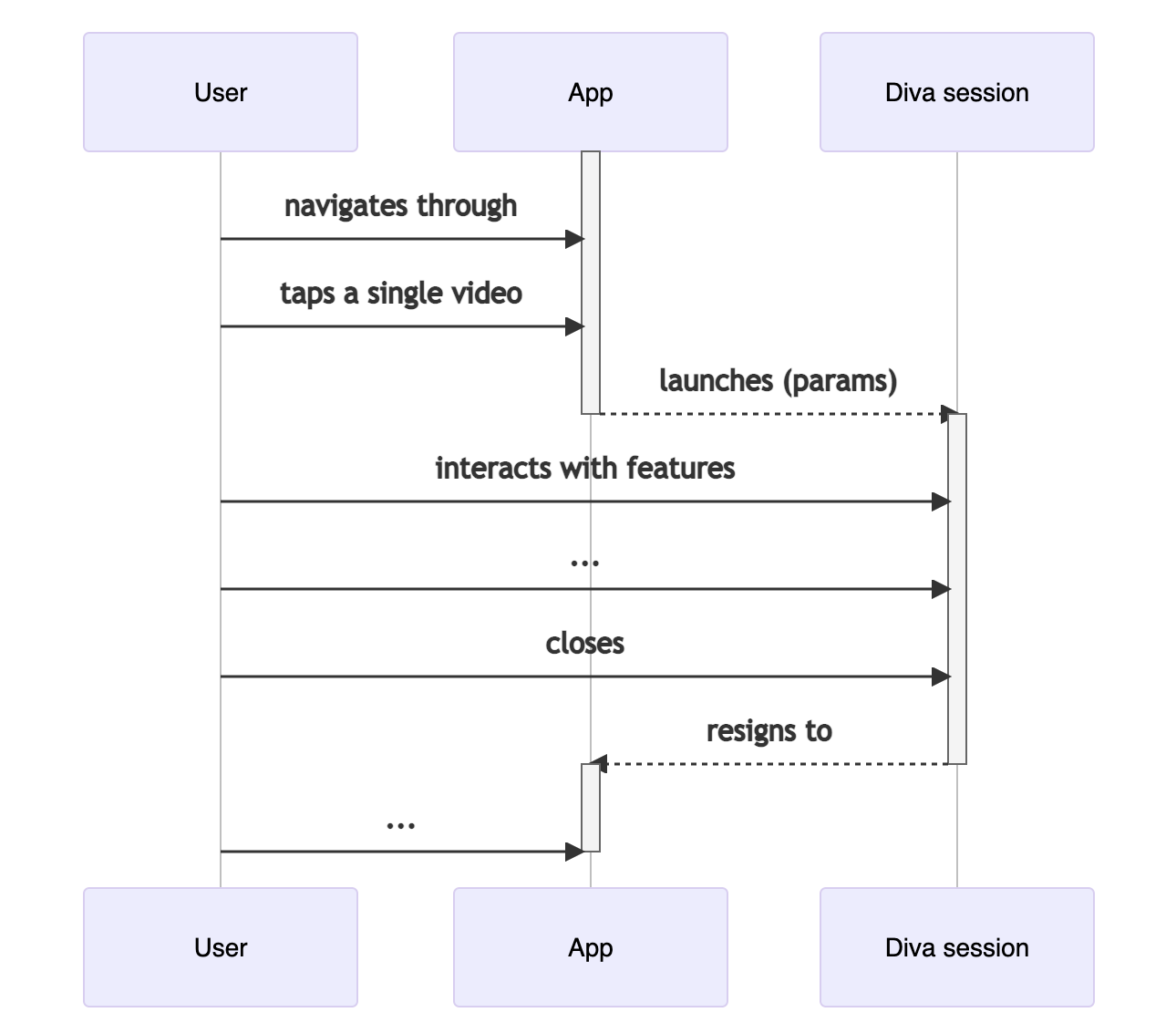What is DIVA?
DIVA is an embeddable video playback component in front-end/client-side applications that provides videos synchronized with relevant data, enhancing the user experience. DIVA is distributed as a client-side SDK for various platforms.
DIVA currently provides SDKs for:
- Android - including AndroidTV and FireTV
- iOS and tvOS
- HTML5, generic HTML for TV, webOS, and Tizen
- Roku
As a component, DIVA delivers a complete user experience covering different aspects of media consumption, mainly:
- Video features: VOD, live, content protection, Advertisements, HDR, etc
- Content discovery: Playback suggestion, End-of-play, Video lists, Side-by-side view, Alternate streams, and many more
- Synchronized data visualization: Infographics, panels, overlays, menus synchronized with user playback position
DIVA features can be configured and activated depending on specific project integrations.
Interaction model
The Embedded Application takes care of the user journey outside DIVA. Usually, this includes navigation that results in lists of videos or articles containing one or more videos. As the user selects a video, the application code launches DIVA effectively, determining the start of a DIVA session.

Please note:
By navigating back and forth, the user will open and close subsequent sessions of DIVA with different videos. DIVA is configurable to include content discovery features (such as VideoLists or Recommendations), whereby users can also navigate through other videos without closing the DIVA session.
A DIVA session
The Embedded Application launches a DIVA session by specifying a number of parameters. Such parameters are the same across different platforms, with most having default values.
For player Instantiation, the videoMetaData, Settings, and Dictionary parameters help configure DIVA. A set of configured parameters is also required for all videos and features. See more on each set of parameters below:
DIVA features
Beyond video playback, the ability to configure and enable features makes DIVA unique.
Please note, most features can be activated or deactivated with no significant efforts in terms of developments or re-deployments of the Embedded Applications in a running project. The ability to activate and deactivate features is critical when facing issues during important live events.
For further information on DIVA and its available features, please visit the DIVA help centre.
The Developer Portal includes detailed technical information about how to enable and run every feature, in addition to edge cases, known issues, differences between platforms, etc. Every description refers to the concepts discussed here (Settings, videoMetadata, pathresolver, etc.) Based on a high-level understanding of the DIVA system, this platform offers extra information depending on your specific requirements.
The DIVA ecosystem
While DIVA delivers a complete frontend UX, such user experience is only made possible by an ecosystem of supporting products and tools within Deltatre.
Frontend ecosystem
As outlined, DIVA is a client-side software component/library/framework concretely delivered in the form of pre-compiled “binaries” for all platforms. For each platform, we provide platform-specific integration guides in addition to a full Testplan app, showcasing UX features and possible configurations across platforms.
Additional client-side components are delivered in source code for projects to customize and adapt based on needs for specific features. This includes:
- DRM: Plugins for connecting to specific license servers
- Chromecast: A DIVA Chromecast receiver
- DataPanels: Javascript utilities for easing the development of webviews
Backend ecosystem
The DIVA player is built to adapt to any existing backend system, including custom CMSs and OVPs. Depending on needs, Deltatre also provides backend components and services to ease the integration and fill the gaps existing projects may have. For new projects, Deltatre can manage the full delivery for new projects, including video production and the video catalog management, transcoding, and advertisements.
When it comes to features related to delivering synchronized data such as the DIVA Timeline and Synchronized Data Panels, data is provided by the Deltatre SDXP division and relayed to DIVA through a back-end component called the Push Engine. It's important to note that for the Synchronization features to work correctly, the video catalog must contain correct timing information for each video.